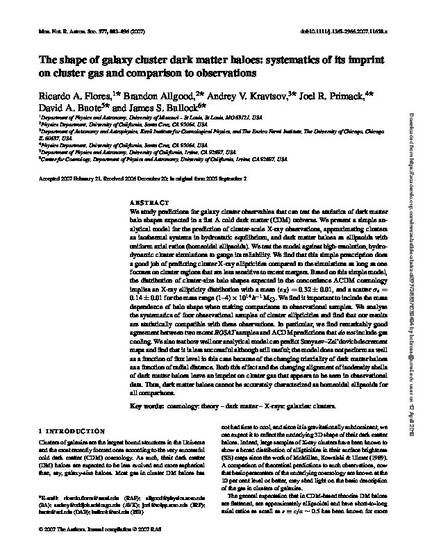
Article
The Shape of Galaxy Cluster Dark Matter Haloes: Systematics of Its Imprint on Cluster Gas and Comparison to Observations
Monthly Notices of the Royal Astronomical Society
(2007)
Abstract
We study predictions for galaxy cluster observables that can test the statistics of dark matter halo shapes expected in a flat Λ cold dark matter (CDM) universe. We present a simple analytical model for the prediction of cluster-scale X-ray observations, approximating clusters as isothermal systems in hydrostatic equilibrium, and dark matter haloes as ellipsoids with uniform axial ratios (homeoidal ellipsoids). We test the model against high-resolution, hydrodynamic cluster simulations to gauge its reliability. We find that this simple prescription does a good job of predicting cluster X-ray ellipticities compared to the simulations as long as one focuses on cluster regions that are less sensitive to recent mergers. Based on this simple model, the distribution of cluster-size halo shapes expected in the concordance ΛCDM cosmology implies an X-ray ellipticity distribution with a mean 〈εX〉= 0.32 ± 0.01, and a scatter σε= 0.14 ± 0.01 for the mass range (1–4) × 1014h−1 M⊙. We find it important to include the mass dependence of halo shape when making comparisons to observational samples. We analyse the systematics of four observational samples of cluster ellipticities and find that our results are statistically compatible with these observations. In particular, we find remarkably good agreement between two recent ROSAT samples and ΛCDM predictions that do not include gas cooling. We also test how well our analytical model can predict Sunyaev–Zel'dovich decrement maps and find that it is less successful although still useful; the model does not perform as well as a function of flux level in this case because of the changing triaxiality of dark matter haloes as a function of radial distance. Both this effect and the changing alignment of isodensity shells of dark matter haloes leave an imprint on cluster gas that appears to be seen in observational data. Thus, dark matter haloes cannot be accurately characterized as homeoidal ellipsoids for all comparisons.
Disciplines
Publication Date
May 11, 2007
DOI
10.1111/j.1365-2966.2007.11658.x
Citation Information
Ricardo A. Flores, Brandon Allgood, Andrey V. Kravtsov, Joel R. Primack, et al.. "The Shape of Galaxy Cluster Dark Matter Haloes: Systematics of Its Imprint on Cluster Gas and Comparison to Observations" Monthly Notices of the Royal Astronomical Society Vol. 377 Iss. 2 (2007) p. 883 - 896 Available at: http://works.bepress.com/ricardo-flores/1/
Creative Commons license

This work is licensed under a Creative Commons CC_BY International License.
